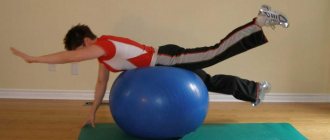So, last time I revealed the secret why you are not losing weight: you eat too much. Today we’ll take the next step and figure out why you’re not losing weight even with a calorie deficit.
Calorie intake is one part of the equation. And the other is expense.
And if with the receipt everything is very simple (you eat food and that’s it), then with the consumption it is more complicated.
Our body is great at maintaining weight and is happy when we gain weight. And vice versa - he doesn’t like getting rid of valuable fat reserves. Here are 8 reasons why we don’t lose weight even at a deficit (and what to do about it all).
You don't have enough patience
It's the same thing all the time:
– I went on a diet, but it doesn’t help. – How long have you been on this diet? - Four whole days! - Four days? - Yes, four days! The diet doesn't work! (Aadam shoots himself)
Yes, yes, most people fail to lose weight for this simple reason: they are too impatient. I’ll explain it on the graph:
When you start a diet and see the first changes for the better, you begin to feel dizzy with success. You think that it will continue to be just as easy, motivation is through the roof. But this is a misconception: you soon move into the next phase, which I call “Sucks” - doing everything right, but no more changes.
This is where many people run out of patience and their diet breaks down. But if you had held out longer, progress would have resumed:
Solution: weight loss CANNOT be forced. You can only hold a deficit, train and wait.
So first of all, calm down and be patient. You didn’t get fat in a week and you won’t lose weight in a week either. I will say more, people who count on the help of a “quick diet” most often gain back everything they lost. They simply cannot withstand too much restriction for long enough and do not develop healthy habits that will help them maintain a healthy weight in the future.
What speed of weight loss should I expect? Depends on the amount of excess fat: the more, the faster it will go away. However, if you are already relatively thin when you start the diet, you may need to lose weight more slowly to maintain muscle and strength.
So aim to lose 0.5-1% (of your total weight) per week. A person weighing 110 kg can lose 0.55-1.1 kg per week, while a person weighing 70 kg should lose 350-700 grams.
Weight standards
When starting the weight loss process, it is very important to set your goals correctly. Often people want to lose a certain amount of kilograms and become a little thinner. However, ideally, you should strive to completely bring your weight back to normal. There are many formulas that can be used to calculate normal weight for an individual person. For example, the well-known Quetelet formula allows you to determine your body mass index. You need to divide your weight by your height cubed. The result is a two-digit number. If it is more than 40, this is grade 3 obesity. From 35 to 39.9 - 2nd degree obesity. From 30 – 1st degree obesity. From 25 - overweight, pre-obese. An index value of less than 18.5 indicates underweight.
There are more complex calculation options. For example, Brocca's formula. She looks like this: (height-X)×1.15. In this case, X = 110 for women and 100 for men with an average build. These are women with a wrist girth from 15 to 17 cm and men with a girth of 18-20 cm. With a wider wrist, women have X = 100, and men have 90. If the wrist is thinner than average, then 120 should be subtracted from the weight for women, and for men 110.
There are a huge number of tables on the Internet where normal weight is already calculated in accordance with gender and age based on one or another calculation method. In addition, there are online calculators that allow you to quickly calculate your norm. In the table below you can see what weight is ideal for men and women of different ages and different body types.
For men
Ideal weight for Men (kg) for the specified body type
| height/age | Asthenics | Normosthenics | Hypersthenics | ||||||
| up to 35 | 35-45 | over 45 | up to 35 | 35-45 | over 45 | up to 35 | 35-45 | over 45 | |
| 158 | 51 | 53 | 55 | 54 | 56 | 59 | 57 | 61 | 64 |
| 160 | 52 | 54 | 56 | 55 | 58 | 60 | 59 | 62 | 65 |
| 162 | 53 | 55 | 57 | 56 | 59 | 62 | 60 | 63 | 67 |
| 164 | 54 | 56 | 58 | 57 | 60 | 63 | 61 | 65 | 69 |
| 166 | 55 | 57 | 59 | 58 | 61 | 64 | 62 | 66 | 70 |
| 168 | 57 | 59 | 61 | 59 | 62 | 65 | 63 | 67 | 71 |
| 170 | 58 | 60 | 62 | 61 | 64 | 67 | 64 | 69 | 73 |
| 172 | 59 | 61 | 63 | 62 | 65 | 68 | 66 | 70 | 75 |
| 174 | 61 | 63 | 65 | 64 | 67 | 70 | 68 | 72 | 76 |
| 176 | 63 | 65 | 66 | 65 | 68 | 71 | 69 | 73 | 78 |
| 178 | 64 | 66 | 68 | 67 | 70 | 73 | 70 | 75 | 79 |
| 180 | 65 | 67 | 70 | 68 | 71 | 75 | 72 | 76 | 81 |
| 182 | 67 | 69 | 71 | 69 | 73 | 76 | 74 | 78 | 83 |
| 184 | 68 | 70 | 73 | 71 | 74 | 78 | 75 | 80 | 85 |
| 186 | 69 | 72 | 74 | 72 | 76 | 79 | 77 | 81 | 86 |
| 188 | 71 | 73 | 76 | 74 | 78 | 82 | 79 | 83 | 88 |
| 190 | 72 | 75 | 77 | 75 | 79 | 84 | 80 | 85 | 90 |
| 192 | 74 | 76 | 79 | 77 | 81 | 85 | 82 | 87 | 92 |
| 194 | 75 | 78 | 80 | 79 | 83 | 87 | 83 | 88 | 93 |
For women
Ideal weight for women (kg) for the given body type
| height/age | fragile | Average | Dense | ||||||
| up to 35 | 35-45 | over 45 | up to 35 | 35-45 | over 45 | up to 35 | 35-45 | over 45 | |
| 155 | 45 | 48 | 48 | 50 | 54 | 55 | 55 | 60 | 62 |
| 157 | 47 | 50 | 50 | 52 | 56 | 57 | 57 | 62 | 64 |
| 160 | 48 | 51 | 51 | 53 | 57 | 58 | 59 | 64 | 66 |
| 162 | 50 | 53 | 53 | 56 | 60 | 62 | 62 | 67 | 69 |
| 165 | 51 | 54 | 54 | 57 | 61 | 63 | 63 | 68 | 70 |
| 167 | 53 | 56 | 56 | 59 | 63 | 64 | 65 | 70 | 72 |
| 170 | 56 | 59 | 59 | 61 | 65 | 66 | 67 | 72 | 74 |
| 172 | 57 | 60 | 60 | 63 | 67 | 68 | 69 | 74 | 76 |
| 175 | 58 | 61 | 61 | 64 | 68 | 69 | 71 | 76 | 78 |
| 177 | 60 | 63 | 63 | 66 | 70 | 71 | 73 | 78 | 80 |
1b. You compare yourself to others
A friend lost weight - what kind of diet is he on? Another one came to the fore - what is his program?
I can't stop you from looking at others and being jealous (we all do it), but understand this important thing: the more you try other people's diets and programs, the less likely you are to succeed yourself. They may have completely different conditions, such as better genetics, or use illegal drugs, or have been training every day for the last 20 years.
Solution: Seek information and ask questions. Don't be afraid to try new things, but once you choose one, dedicate plenty of time to it. In short, patience.
Metabolic adaptation
But the main biological reason is the adaptation mechanism of our metabolism. Although we typically think of metabolism as one concept, it has four distinct components: basal metabolic rate (BMR), non-exercise thermogenesis (NEAT), exercise thermogenesis (EAT), and the thermic effect of food (TEF).
BMR: While you are sitting and reading this great text, a lot of different processes are going on in your body. The brain processes the information, the eyes, running across the screen, jump to the beauty sitting opposite, and the heart beats faster when she also looks at you. All of this, believe it or not, burns calories and is called basal metabolism. This is the main expense item, reaching 60-70% for most people.
NEAT: Any physical activity that is not training. Fidgeting in a chair, walking, walking the dog, etc. Burns about 30% of calories, but can be higher if, for example, you have to move a lot at work.
EAT: Just training. The number of calories burned depends on the type and duration of exercise. For example, a short strength workout takes less than an hour of running. For most of us, this component accounts for only 10-15% of calories consumed. This is why it is almost impossible to overcome a bad diet with exercise.
TEF: The number of calories it takes to digest food. Although this is only 5-10%, it must also be taken into account.
Losing weight affects all four components.
- BMR: The smaller the body, the less it spends
Basal metabolism is determined by dimensions: height, weight, volume of muscle tissue, percentage of fat, etc. When you lose weight, your body weight decreases and requires fewer calories.
Solution: The deficit must be adjusted from time to time to match the changed weight.
First, track your weight changes.
Weigh yourself daily, in the morning, leaving the toilet and before reaching the kitchen. This way you will collect the most accurate data. Once you have your measurements for the week, calculate the average. Why weekly average? Because the weight fluctuates from day to day due to a variety of factors:
As you can see, although the weight may increase on some days, the weekly average is slowly but surely decreasing.
- Volumes
The numbers on the scale aren't everything. Also record the main body volumes, they will help you better understand whether there is progress and whether you need to adjust your diet. Measure once a week (at the same time, under the same conditions).
- Photo
Photos will help you look at your progress from the outside. Here is my article and video where I discuss the above three points in more detail.
Secondly, when starting a diet, do not change anything for the first 4 weeks.
The body needs a little time to get used to the deficit. During this period, you will become clear whether you need to recalculate your caloric intake.
Let's say you endured 4 weeks on the initially established deficit, and the weight loss stopped. What to do? Just reduce your caloric intake by 5-10% . If you started at 2500, subtract 125-250 calories.
Here, many are perplexed by the question of what to cut - proteins, fats or carbohydrates? Don't touch the protein or you'll die! Just kidding, you won’t die, but leave the protein portion unchanged.
If you are on a high carb diet, then cut them: reduce them by 30-60 grams (~125-250 calories). If you are on a diet with a lot of fat, then cut it: since there are 9 calories per gram of fat, then reduce it by 13-27 grams.
Let me remind you that in the most carbohydrate-precarbohydrate diet, fat should contain at least 15% of the total calories. Because #health.
With each calorie change, continue to take all measurements for 2-3 weeks, then, if necessary, reduce by another 5-10%.
NEAT: Those who are losing weight move less
Yes, it's that simple. Here are links to the studies: , , . We move less while on a diet, and our daily calorie expenditure decreases.
Solution: choose the time or number of steps yourself. “40 minutes of walking every day” or “10,000 steps every day.”
This will help you maintain approximately the same calorie burn. And it also encourages the “eat more, move more” , which I am a fan of. And even studies (here and here) say that this strategy is much more effective than the popular “eat less - move more.”
TEF: The less you eat, the fewer calories are spent on digestion.
EAT: The lighter the weight, the less you burn in training.
How to monitor your diet
To switch to proper nutrition and not consume calories in excess of what the body requires, you need to constantly count calories. Some people trying to lose weight use tables, special apps, calorie calculators and count everything they eat during the day. Others schedule the menu a week or two in advance. This is a more convenient option that allows you not to think about kilocalories every hour. You can entrust the preparation of a weekly menu to a specialist, and then just stick to it and not be tricky with constant calculations. But for those who spend a lot of time outside the home, often eat in restaurants and do not have the opportunity to eat only personally prepared food, it is easier to keep calculations throughout the day. The main thing is not to lose vigilance and adhere to the established norm.
Switching to a lower calorie diet is usually accompanied by a persistent feeling of hunger. In this state, a person constantly thinks about food, which further stimulates the appetite. Nutritionists advise sticking to fractional meals, which allows you to reduce your daily caloric intake with minimal discomfort. The simplest option for fractional nutrition is to distribute all daily calories into 5 meals. The portions will be smaller, but the time interval between meals will also be reduced.
For breakfast, you should choose foods with “slow” carbohydrates. They will be digested longer, maintaining a feeling of fullness. For dinner, it is recommended to eat quickly digestible food.
It is quite difficult to monitor your diet all the time. This can get boring quickly. But to lose weight and maintain an ideal figure, it is not more important to control your diet, but to develop the right eating habits. You need to gradually learn to eat less, according to a schedule, using healthy foods. In order to stimulate metabolism, you should start the day with a glass of lemon water and prepare oatmeal for breakfast. Make it a habit to drink plenty of fluids frequently and exercise regularly.
Fluid retention
Diet (and exercise) is stressful. And stress increases cortisol. And cortisol retains water. This is usually more noticeable in women, for example, my client. Only a week passed between the two photos:
Water retention “masks” weight loss: fat goes away, but it seems to you that nothing is happening.
The red line is the constant numbers when weighing, and the green line is the REAL reduction in fat.
Solution: Calm down.
Don't go on a diet during a difficult period in your life. If there is too much stress, then you will not lose weight, and you will also injure yourself in the gym. Choose a relatively quiet time to diet.
Here's what can help reduce stress:
- Meditation: here I’m just pretending to be a guru who knows how to relax. In fact, I hate meditation! I tried. Nothing works. BUT. The benefits have been proven by science, and some even know how to enjoy the process. I don't know, my experience is described here.
- Walking: This is my meditation – I love walking. Every morning I walk for half an hour, thinking positive thoughts (and leaving my phone at home).
- Massage: Even one treatment per month can significantly reduce stress.
- Sex.
- Journaling: Get your thoughts out of your head and onto paper. At least scribble.
- Don't write 3000+ word articles. Don't be like me.
And be sure to add a separation phase.
I described the phase diet in detail here, here is the Twitter style:
Step back from your diet for 1-2 weeks, adding calories (mostly carbohydrates) to maintenance levels or slightly more. This will reduce stress and drain the water.
Who is calorie acceleration indicated for?
- For those who are on a low-calorie diet and want to slowly return to a normal diet.
- For those who intend to gradually reduce their kcal deficit.
- For those who have lost weight and want to stop, get off the diet and not gain it back.
- For those who have tormented themselves with various fasting for a long time and want to return to a normal life and tasty food, while continuing to lose weight comfortably.
The acceleration principle is simple. It is necessary to slowly but surely increase calorie intake, allowing the body to adapt to new conditions without slowing down the rate of weight loss. Gradually you will reach an adequate number of calories per day, which you can then safely reduce. You can easily lose weight, for example, by 2000 kcal per day (everything is individual, but the prospect is tempting, especially after a diet of 1000).
Health problems
Many things can affect your weight, such as hypothyroidism, polycystic disease, or menopause. Certain medications (such as antidepressants or oral contraceptives) can even make you fat.
Solution: If you follow a strict diet and exercise hard, but your weight does not change, then go to the doctor and get your health checked.
Regarding medications and weight gain, I consulted Dr. Spencer Nadolsky aka The Doc Who Lifts:
- Ask your doctor if there are alternatives. Sometimes yes, sometimes no.
- If not, then accept the need to be treated with the same drugs. Work on what you can control.
- There are also drugs that help, for example, metformin or antipsychotics. Appetite suppressants may be useful if your primary medication increases appetite.
But let me remind you that I am not a doctor. All I can say is “consult a specialist.”
Carbohydrates, salt and water balance
leanitup.com
The most common reason for the slowdown in weight loss and what is considered a “metabolic breakdown” is this. Typically, a person will easily and quickly lose 3-5 kg in the first couple of weeks of the diet, which is very encouraging. But dramatic weight loss occurs due to getting rid of excess water and swelling.
A typical diet for weight loss involves limiting carbohydrates (especially simple ones - flour, sweets) and completely avoiding canned foods (sauces, pickles, marinades), sausages, sausages, cheeses, chips, pizza and other high-calorie foods full of salt.
Carbohydrates and salt are what keep water in the body. Reducing them easily relieves a person who has just started a diet from the first few kilograms due to the removal of excess water.
After this, the rate of weight loss quickly decreases, because adipose tissue is activated, which disappears much more slowly - 300-500 grams per week can be considered an excellent result.
But not only has the rate of weight loss dropped significantly, but after a person eats carbohydrates or something salty, he or she will experience weight gain—again due to water. Hence the thoughts about a broken metabolism and weight gain out of thin air.
You're losing weight wrong
We need to get rid of FAT, not WEIGHT. These are different things. Left – weight loss, right – fat loss:
In addition to fat, our body contains many useful things: skeleton, muscles, organs, water, etc. All this adds up to the total mass. Losing weight is easy: eliminate carbohydrates... whatever - stop eating! You will definitely lose weight. And then you'll probably die.
Losing fat is a more complex process in which you get rid of excess reserves, but maintain useful mass.
Here are the key points:
- Get enough protein
- Keep training with weights
- Maintain a reasonable calorie deficit
Solution:
- Exercise and eat enough protein: This study and this study confirm that dieting preserves muscle.
- Lose weight by only 0.5-1% per week. At this rate of weight loss, the loss of muscle mass is minimal.
Until the end of August 2022, through our affiliate program with FitStars with the promo code ZOZHNIK, you can buy lifetime access to the entire database of video training for 3,326 rubles instead of 11,880 rubles or an annual subscription for 137 rubles per month (1,646 rubles per year).
You're getting fat
Now imagine that calories are a salary. Every day you spend money on food, transportation, housing, utilities, etc. In reality, this is energy expenditure for walking, thinking, digesting food and much more.
So, if your salary exceeds your expenses, you accumulate financial resources - calories. Where should the accumulated funds go? That's right - they need to be put aside in reserve.
You can store excess unused energy in the human body by creating fat stores. This is how you gain weight.
You are gaining muscle
If your weight does not decrease and even increases (and calories are under control), then, most likely, you are starting to gain lean mass.
Solution: I think I’ve already said this, but I’ll repeat: the numbers on the scales aren’t everything. Measuring your volume and taking photos (and lifting weights in the gym) will tell you a lot more about your fitness.
Volume: if your arms, chest and quadriceps increase, and your waist decreases, then congratulations, you have gained muscle.
Photo: Looking bigger than before? Are lines drawn on your body that you haven’t seen before? Congratulations, you have gained muscle.
Strength: If your strength hasn't dropped at a deficit (or even increased a little), then congratulations, you've gained muscle.
Calorie consumption example
Based on the tabular data, we will calculate the approximate consumption for a person with an athletic build (up to 20% fat tissue) weighing 75 kilograms. The net weight of such a person is 60 kilograms.
- Sleep 8 hours – up to 720 kcal. Why so much? Everything is very simple. During sleep, the body rearranges all functions, launches intense anabolism, and in some phases of sleep, on the contrary, catabolic processes begin.
- High intensity training – 1 hour – 1080 kcal.
- Office work – 8 hours – 576 kcal.
- Meals (5 pieces) for 15-20 minutes. -60-80 kcal.
- Walking to work and back – 1 hour 210 kcal.
- Gaming – 2 hours a day – 100 kcal.
- Passive consumption – 720 kcal.
The total consumption, not counting small activities, is 3500-3700 kcal. To create the correct deficit, it is necessary to limit food to 3000-2800 kcal. In the absence of training, the consumption per day is 2500-2700. Accordingly, nutrition on days without training is 2000-2200 kcal.
Recipes for healthy eating
Cannelloni with ricotta and spinach
- 9.9 g Protein
- 5.3 g Fat
- 12.1 g Carbohydrates
- 141.2 kcal
40-50 min.
- #second course
- #dietary
- #baking
- #cream cheese
- #low calorie
- #dinner
- #vegetable oil
- #sour cream
- #spices
- #dinner
- #spinach
Other recipes
You don't need to reduce your fat percentage yet
This is not what you WANT to hear, but what you NEED to hear. If you lack muscle mass and are trying to lose fat, the results will be disastrous. Let's return to our Bales:
Both photos show “relief” indicating a reduced percentage of fat, but how do you want to look yourself? Personally, I prefer to be Batman with muscles.
The more muscle mass you have, the better you will look after dieting. If there is clearly not enough muscle, then you should not burn fat, but build muscle. This also applies to girls.
If you are not yet twenty, then do not go on a diet (except in cases of real obesity). Now you are in a “golden” period of growth. Eat well and train hard to make the most of this wonderful time. You'll have the rest of your adult life to worry about on boring diets.
Safe deficit
When you are advised to lose weight by 1000 kcal, they are offering the diet of a child or a concentration camp prisoner. You need to understand that you won’t be able to live from hand to mouth for long, which means you’ll either lose it or gain all the lost kilos back by returning to a normal diet.
Safe deficit
A safe recommended deficit is 10-20% of daily calories. For example, your norm is 1900 kcal. Then reducing the daily amount costs 190-380 kcal. Never fall below this limit, otherwise you will put your body under stress, forcing you to greedily stock up on resources from literally everything that gets into your mouth. Women on a diet may stop having periods, hair loss, and nails crumble. And all this in addition to obsession with food and emotional instability.
You need to STOP dieting.
Do you suffer from chronic dietosis? Well, you know: one week - massaging, another - drying, and so on:
If you get off one diet and start the next one within a week, this will not improve your health or figure. But here's what it will lead to:
- Loss of muscle mass: The longer you remain in a calorie deficit, the more muscle you lose. This is why I recommend a phase diet with periods of maintenance calories or even a slight surplus.
- Eating disorders: It is possible to live on a limited calorie diet, but not for too long. When you go overboard with the duration, deviations can also develop: breakdowns, feelings of guilt for breakdowns, new starvation - and everything goes in a spiral, getting worse and worse.
- Zero Result: If you do the above, you are simply wasting time and achieving nothing.
Solution: if you recognize yourself in the description of the last point, then it’s time to give up diets for a while.
Raise your calories to maintenance levels and focus on training while restoring your psyche. You may gain some fat during this period, but you need to bounce back to achieve your goal in the future.
Source: physiqonomics.com Translation: Alexey Republicommando
Let's say today you ate for lunch:
- Vermicelli soup - 270 kcal - Two fried pork chops - 530 kcal - French fries (140 g) - 420 kcal - A glass of sweet compote - 170 kcal
As a result, we get as much as 1390 kcal.
Let's try to choose other dishes and create a small calorie deficit:
- borscht (250 ml) - 200 kcal - one fried pork chop - 265 kcal - mashed potatoes with butter 170 kcal - a glass of dried fruit compote - 130 kcal
As a result, we will get less - 765 kcal
If you can’t lose weight, let’s try to further increase the calorie deficit and take it for lunch:
- lean borscht (200 ml) - 100 kcal - salad of tomatoes, cucumbers and green leaves - 50 kcal - a little beef stew (115 g) 210 kcal - mashed potatoes with butter - 170 kcal - glass of water - 0 kcal
The result is a meal for 530 kcal
Which lunch to choose? How much should you reduce your calorie intake to lose weight?











